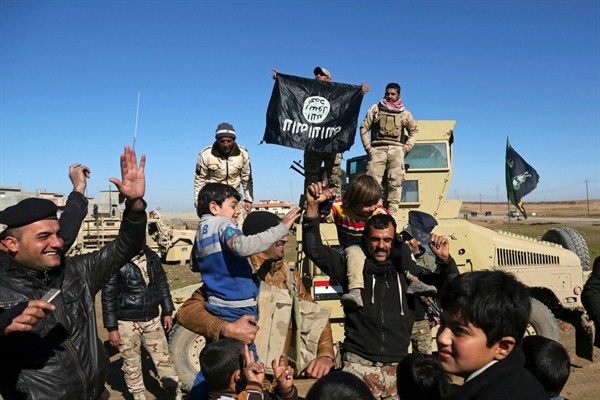As the forces of the U.S.-led coalition continue to push the so-called Islamic State out of its heartland in Syria and Iraq, the group isn’t exactly disappearing. Rather, it has sought out new footholds across the region and beyond, stepping up transnational terror attacks to keep its brand from fading. World Politics Review has compiled 11 articles tracing the Islamic State’s evolution, and what its changing outlook means for the international battle to combat it.
Purchase this special report as a Kindle e-book.
A Complex Battlefield
As the Islamic State Disperses, the United States Must Adapt
Though it has been tough, bloody work, the Iraqi military and local militias, backed by U.S. forces, are slowly driving the Islamic State out of its self-proclaimed caliphate in northern Iraq and eastern Syria. Unfortunately, Steven Metz suggested this month, this will simply drive the group to other locations, forcing the U.S. and its allies to adapt.
Iraqi Prime Minister Haider al-Abadi visited Washington last week, and the Trump administration greeted him by approving more troops for the fight to retake Mosul, which has been the Islamic State’s stronghold in Iraq since 2014. But what remains to be seen, wrote Ellen Laipson this week, is whether Baghdad and the U.S. will devote the necessary resources to maintaining stability after the group is rooted out.
In January, Steve Metz called the battlefield defeat of the Islamic State “far from certain but increasingly likely.” Seeing the group driven out of Syria and Iraq would be good news in the U.S. and Europe, but would not represent a decisive victory, as the conflict will only continue to perpetuate itself in other forms. U.S. policymakers must be sensitive to this as they craft a way forward.
The Regional Dynamic
Tunisia’s large cohort of nationals fighting among the ranks of the Islamic State is becoming a domestic problem, WPR Associate Editor Karina Piser explained this month, as leaders in Tunis struggle with how to handle the return of battle-hardened combatants. The country’s muddled response to returning jihadis risks overshadowing its notable progress in consolidating democracy.
Reports of Chinese security forces operating in Afghanistan have prompted speculation about whether Beijing has crossed another important threshold in its policy on overseas military activity. Last week, Andrew Small looked at the convergence of several underappreciated trends in the region—many centered on the Islamic State—that are likely to drive more Chinese counterterrorism activities in future.
December’s terrorist attack in Jordan, for which the Islamic State claimed responsibility, was a brutal reminder of the kingdom’s fragile security situation, WPR’s senior editor, Frederick Deknatel, wrote at the time. For all the worries about homegrown extremism in Jordan, though, the attack actually revealed a popular rejection of the Islamic State. Can Jordan and other regional governments balance suppressing extremism and sustaining the people’s goodwill?
The Competition
With the Islamic State on the Ropes in Mosul, Al-Qaida Makes a Comeback
The beginning of the offensive to retake Mosul marked a turning point in efforts to defeat the Islamic State, which has lost as much as 90 percent of the territory it held at the height of its power. Unfortunately, argued Frida Ghitis at the outset of the battle in October, the group’s decline has provided an opening for its principal rival, al-Qaida, to revive its brand. The predicament highlights the continued relevance of jihadi ideology—with or without the Islamic State.
Last January, Leah Farrall unpacked the Islamic State and al-Qaida’s competing recruitment strategies. The ascendance of the Islamic State, along with the resilience of al-Qaida, have as much to do with local factors driving individual and group dynamics as they do with ideological appeal.
Into Africa?
In November, Anouar Boukhars warned of the dangers of growing militancy in the Sahel and West Africa. Both the Islamic State and al-Qaida in the Islamic Maghreb have expanded their footprint in the region, particularly in economic hubs and coastal areas that had previously been spared from violence. Unless regional governments and international actors change their strategy, instability will likely deepen.
Meanwhile, the Islamic State’s strategy to expand into North Africa has begun to falter, Nathaniel Barr argued in January. Besieged in Mosul and on the defensive in parts of Syria, the future of the group’s North African network has been thrown into question. As the group continues to lose ground, its North African affiliates may become disconnected or try to distance themselves from the flagging Islamic State brand.
East Africa, too, may prove a futile venture for the Islamic State, Joshua Meservey wrote in January. As concerning as recent news about its presence in Somalia is, it should not distract counter-extremism efforts from the primary threat in Somalia and the region: al-Shabab, which has maintained an imposing presence there for years, and already has deep ties with al-Qaida.

